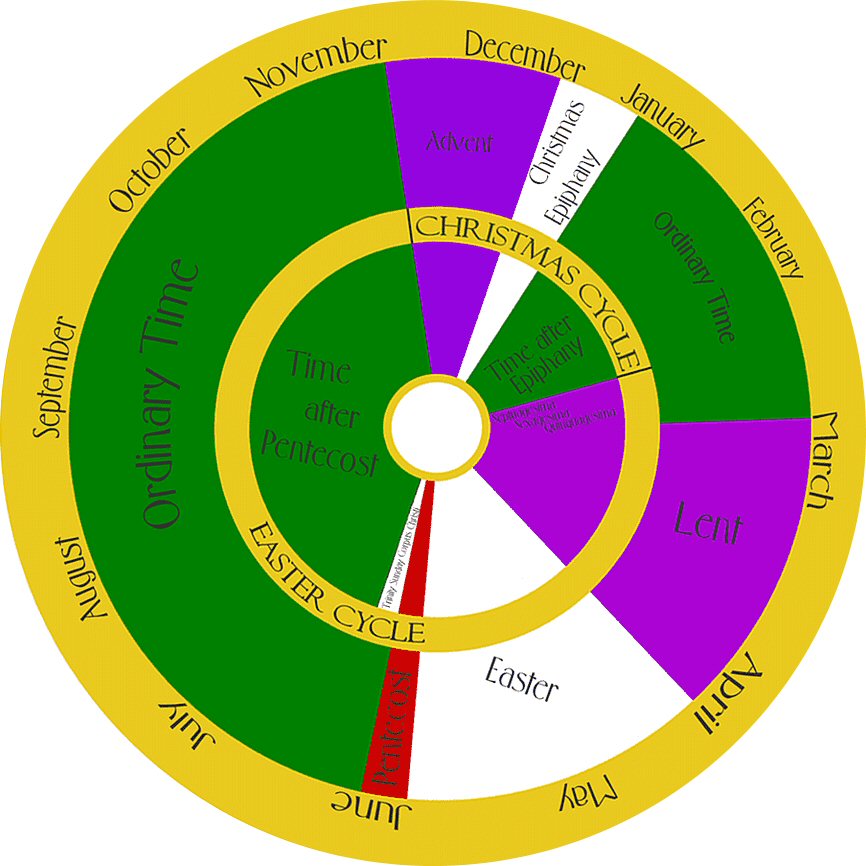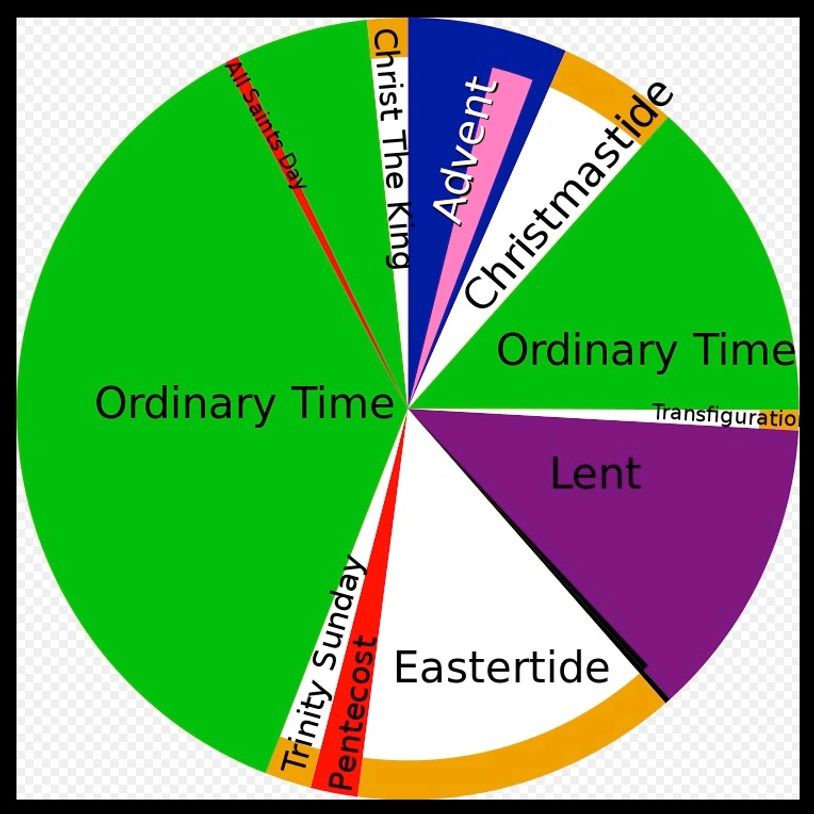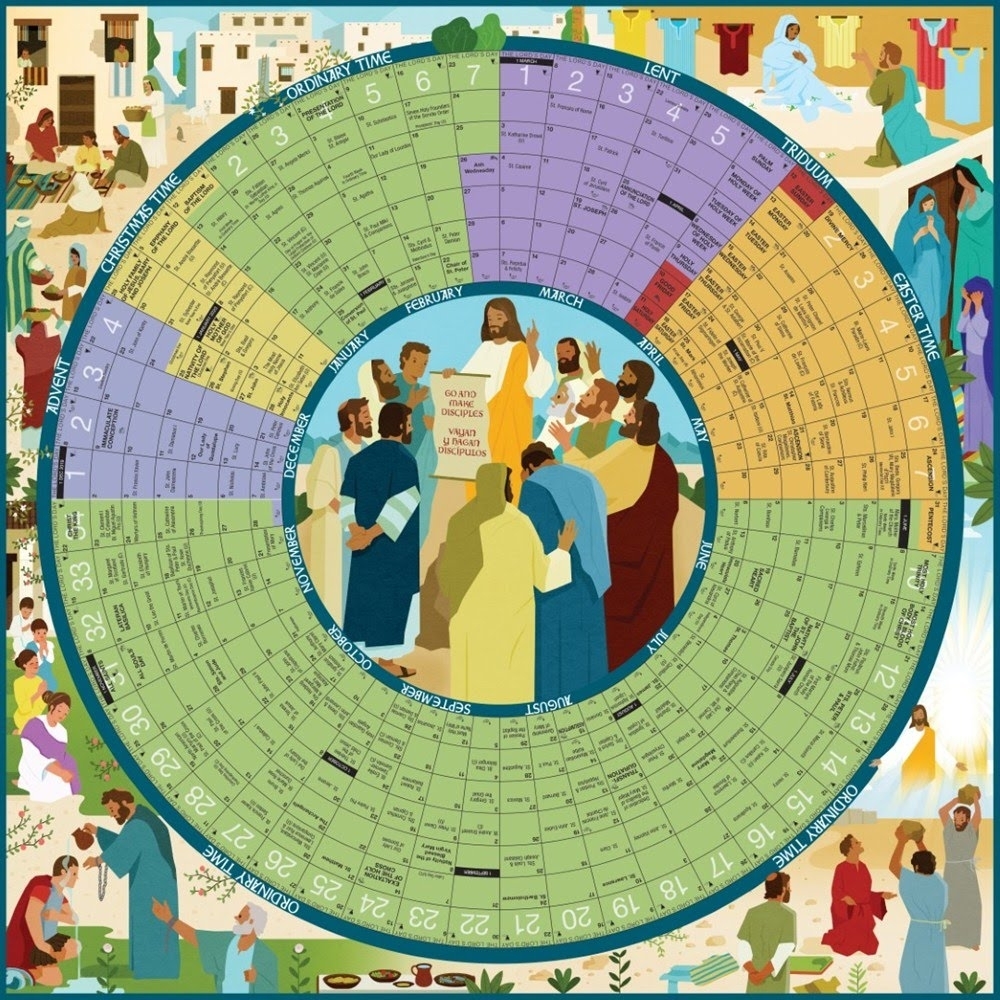Liturgical Colors Calendar - The use of colors to differentiate liturgical seasons became a common practice in the western church in about the fourth century. Dates on white stand for light and the festivals of christ. In the liturgical calendar, the color for each day corresponds to that day's main liturgical celebration, even though optional memorials. Each color’s meaning is explained below: “liturgical colors” in episcopal worship signify our place in the church year: Traditionally, five basic colors of a festive, penitential, and neutral nature have been used in most liturgical congregations. White, the color of jesus’ burial garments, for christmas, easter,. Indicates royalty, repentance, and suffering.
White, the color of jesus’ burial garments, for christmas, easter,. In the liturgical calendar, the color for each day corresponds to that day's main liturgical celebration, even though optional memorials. Dates on white stand for light and the festivals of christ. The use of colors to differentiate liturgical seasons became a common practice in the western church in about the fourth century. Each color’s meaning is explained below: Indicates royalty, repentance, and suffering. Traditionally, five basic colors of a festive, penitential, and neutral nature have been used in most liturgical congregations. “liturgical colors” in episcopal worship signify our place in the church year:
Dates on white stand for light and the festivals of christ. The use of colors to differentiate liturgical seasons became a common practice in the western church in about the fourth century. Indicates royalty, repentance, and suffering. Traditionally, five basic colors of a festive, penitential, and neutral nature have been used in most liturgical congregations. In the liturgical calendar, the color for each day corresponds to that day's main liturgical celebration, even though optional memorials. Each color’s meaning is explained below: “liturgical colors” in episcopal worship signify our place in the church year: White, the color of jesus’ burial garments, for christmas, easter,.
Colors Of The Catholic Liturgical Calendar Heddi Brandie
Dates on white stand for light and the festivals of christ. Traditionally, five basic colors of a festive, penitential, and neutral nature have been used in most liturgical congregations. In the liturgical calendar, the color for each day corresponds to that day's main liturgical celebration, even though optional memorials. The use of colors to differentiate liturgical seasons became a common.
Liturgical Colors Calendar Zorah Kiersten
Each color’s meaning is explained below: “liturgical colors” in episcopal worship signify our place in the church year: The use of colors to differentiate liturgical seasons became a common practice in the western church in about the fourth century. In the liturgical calendar, the color for each day corresponds to that day's main liturgical celebration, even though optional memorials. White,.
Liturgical Calendar And Colors Printable Calendars AT A GLANCE
Dates on white stand for light and the festivals of christ. In the liturgical calendar, the color for each day corresponds to that day's main liturgical celebration, even though optional memorials. Traditionally, five basic colors of a festive, penitential, and neutral nature have been used in most liturgical congregations. The use of colors to differentiate liturgical seasons became a common.
Lutheran Liturgical Calendar Colors 2025 Alexis Boyle
Each color’s meaning is explained below: “liturgical colors” in episcopal worship signify our place in the church year: White, the color of jesus’ burial garments, for christmas, easter,. Dates on white stand for light and the festivals of christ. Indicates royalty, repentance, and suffering.
Liturgical Year Calendar Printable
The use of colors to differentiate liturgical seasons became a common practice in the western church in about the fourth century. “liturgical colors” in episcopal worship signify our place in the church year: In the liturgical calendar, the color for each day corresponds to that day's main liturgical celebration, even though optional memorials. Indicates royalty, repentance, and suffering. Dates on.
2025 Liturgical Color Calendar Umc Mary B. Macfarlane
The use of colors to differentiate liturgical seasons became a common practice in the western church in about the fourth century. Indicates royalty, repentance, and suffering. In the liturgical calendar, the color for each day corresponds to that day's main liturgical celebration, even though optional memorials. White, the color of jesus’ burial garments, for christmas, easter,. “liturgical colors” in episcopal.
The Liturgical Colors The Church of the Advent, Cynthiana, an
The use of colors to differentiate liturgical seasons became a common practice in the western church in about the fourth century. Each color’s meaning is explained below: White, the color of jesus’ burial garments, for christmas, easter,. “liturgical colors” in episcopal worship signify our place in the church year: In the liturgical calendar, the color for each day corresponds to.
Roman Catholic Liturgical Calendar Colors prntbl
“liturgical colors” in episcopal worship signify our place in the church year: In the liturgical calendar, the color for each day corresponds to that day's main liturgical celebration, even though optional memorials. Dates on white stand for light and the festivals of christ. Each color’s meaning is explained below: Traditionally, five basic colors of a festive, penitential, and neutral nature.
Calendars With Liturgical Colors 2024
The use of colors to differentiate liturgical seasons became a common practice in the western church in about the fourth century. White, the color of jesus’ burial garments, for christmas, easter,. “liturgical colors” in episcopal worship signify our place in the church year: Dates on white stand for light and the festivals of christ. Traditionally, five basic colors of a.
Liturgical Calendar With Lectionary 2024 Ali Melisse
Indicates royalty, repentance, and suffering. In the liturgical calendar, the color for each day corresponds to that day's main liturgical celebration, even though optional memorials. Each color’s meaning is explained below: Traditionally, five basic colors of a festive, penitential, and neutral nature have been used in most liturgical congregations. The use of colors to differentiate liturgical seasons became a common.
Each Color’s Meaning Is Explained Below:
“liturgical colors” in episcopal worship signify our place in the church year: White, the color of jesus’ burial garments, for christmas, easter,. Dates on white stand for light and the festivals of christ. In the liturgical calendar, the color for each day corresponds to that day's main liturgical celebration, even though optional memorials.
Traditionally, Five Basic Colors Of A Festive, Penitential, And Neutral Nature Have Been Used In Most Liturgical Congregations.
The use of colors to differentiate liturgical seasons became a common practice in the western church in about the fourth century. Indicates royalty, repentance, and suffering.









